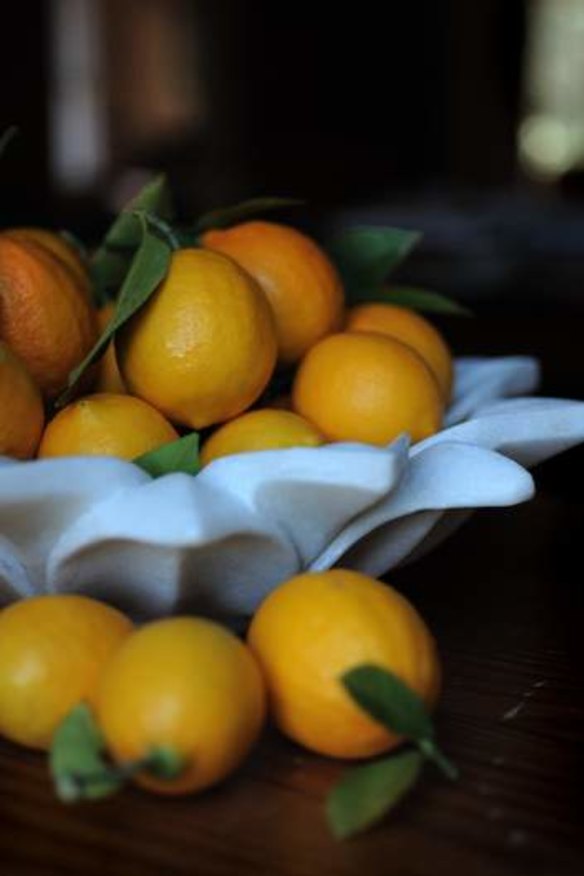Answering your vexing culinary questions

How do I get the wax off waxed lemons? Use petrol? R. Balzary
Dear Mr Balzary, please, no matter how frustrated your search for unwaxed lemons gets, do not use petrol in the kitchen. The mix of volatised fuel and hot appliances can lead to unintended consequences. I blame the backyard renovation shows. In the old days, every Australian backyard had a lemon tree that not only supplied fresh lemons for most of the year, it doubled as a gentleman's nocturnal urinal. Now you're more likely to find clivias and a water feature. If you have space - plant a lemon tree. You'll thank me in a few years. You can find unwaxed citrus at farmers' markets and organic stores. Alternatively, wash waxed lemons in hot water to remove the wax. The wax is carnauba wax derived from a tropical plant and is non-toxic and hypoallergenic.
Every time I order pork belly while dining out, it's always served warm and never hot. A. Andreadis
After an initial burst of heat to get colour on the skin, it takes a long time of slow cooking to break down the muscle fibres in the pork belly so it has that melt-in-the-mouth texture. As the muscle cooks, the interlaced fat liquifies, bathing the flesh and making it more moist. This is done before service. When you order your pork belly, it may be reheated on a pan in the oven. To get the core temperature hot would mean leaving the meat in the oven so long that the fat would render out of the meat, threatening to dry it out. Roasted and grilled meats should be served warm - a sign they have rested. Sydney chef Alex Herbert is quite vocal about meat temperature, saying we are conditioned to think flesh should arrive on the table steaming, ''thanks to ads on the telly''.
Can you make custard out of rice milk or almond milk? P. Jackson
I did. This morning. I chose almond milk because it has naturally occurring oil from the almonds, giving it about 2.7 per cent fat, a little less than milk's 3.4 per cent. I poured two cups of almond milk into a heavy-based saucepan with four tablespoons of raw sugar and half a vanilla bean. I simmered it for a few minutes then allowed the mixture to cool before removing the vanilla bean. I gently beat four eggs in a cup and added these to the almond milk, placing it on low heat. It took 20 minutes of slow mixing to reach the right temperature for the eggs to thicken the mixture. I was using a whisk to stir as this was closest to hand but found that the almond milk frothed and held foam more than custard made with milk so changed to a wooden spoon. The flavour is less rich than custard made with milk, however it is quite good.
I am making ice-cream. How do I stop the base (custard) from curdling, and where can I find pistachio flavouring? S. Gold
Two custard questions in one week. Excellent. When you think about the amount of milk, cream, eggs and sugar that goes into real ice-cream, you wonder why we eat such energy-dense foods on hot days. By heating those ingredients together, we are wanting a few things to happen. We need the sugar to dissolve so the ice-cream is not gritty. We need the protein in the eggs to coagulate and form a network that traps the liquid and thickens the custard. This happens at between 79 and 83 degrees Celsius. Take it above this temperature and the proteins tense up, the network falls apart and water emerges. Curdled custard. Avoid this by heating the custard very gently. Use a thermometer if necessary. If the custard looks as though it's about to curdle, pour it into a cool bowl and whisk to reduce the temperature. Return it to very low heat if necessary. Or try reducing the heat and whisking in a little cold cream. Now, as far as pistachio flavouring goes, perhaps consider roasting fresh pistachios on a tray for five minutes, rubbing them to remove the skins, and grinding them with a little sugar in a mortar and pestle or a high-speed blender to form a paste. Add a few drops of almond oil to intensify the flavour then add this to the mixture as the recipe instructs. For a little texture, add roughly chopped roasted pistachios before the ice-cream sets. Try this with hot figs and a drizzle of Pedro Ximenez.
brainfood@richardcornish.com.au
The best recipes from Australia's leading chefs straight to your inbox.
Sign up- More:
- Brain food
